 Journal of Applied Mathematics and Physics, 2013, 1, 98-104 Published Online November 2013 (http://www.scirp.org/journal/jamp) http://dx.doi.org/10.4236/jamp.2013.15015 Open Access JAMP Spectral Analysis and Variable Structural Contro l of an Elas t i c B e am Xuezhang Hou Mathematics Department, Towson University, Baltimore, USA Email: xhou@towson.edu Received September 6, 2013; revised October 8, 2013; accepted October 19, 2013 Copyright © 2013 Xuezhang Hou. This is an open access article distributed under the Creative Commons Attribution License, which permits unrestricted use, distribution, and reproduction in any medium, provided the original work is properly cited. ABSTRACT An elastic beam system formulated by partial differential equations with initial and boundary cond itions is investigated in this paper. An evolution equation corresponding with the beam system is established in an appropriate Hilbert space. The spectral analysis and semigroup generation of the system operator of the beam system are discussed. Finally, a variable structur al control is proposed and a sign ificant result that the solution of the system is exponentially stable un- der a variable structural control with some appropriate conditions is obtained. Keywords: Spectral Analysis; Semigroups of Linear Operators; Elastic Beam System; Variable Structural Control 1. Introduction A great attention has been paid to the dynamics and con- trol of flexible robot (see [1-5]) in the past thirty years since the high-speed performance and low energy con- sumption are highly demanded. In this paper, as a con- tinuation of our work [6-9], we shall investigate an elas- tic robot system formulated by partial differential equa- tions with initial-boundary value conditio n s. By means of functional analysis and semigroups of linear operators, the beam system is described as an evolution equation in an appropriate Hilbert space. Spectral properties and semigroup generatio n of the system operator corr espond- ing to the evolution equation are studied. Several signifi- cant results are obtained. Let us consider a robot system composed of two link-arm and three joints, an electrical machinery is in- stalled on each joint, the beam connecting with based stand is rigid and forearm is elastic. By means of the space kinetic and Hamilton's variation principle, we can obtain the following second-order hyperbolic system that describes the motion of the elastic beam system [10]: 22 2 1 22 2 3 2 1 22 ,, , cos uxt uxt px tx x uxt px xtx Lxg (1) 22 2 2 22 2 3 2 2 22 ,, , cos cossin vxt vxt px tx x vxt px xtx Lx x (2) with the following boundary conditio ns: 11 0,0, 0,, 0,,,ututpu ltpultmg (3) 22 0,(0, )0,,0,,0,vtvtpv ltpvlt (4) and initial condition s 01 01 01 10 ,0,,0(); ,0, ,0, 0,0;0 0;0 ,0 ux uxux ux vxvxvxv x 0 1 , , where ,, ,uxt vxt are vertical and horizontal bend- ing vibration displacements of the forearm of the robot respectively; 1 px 1 , and are vertical and hori- zontal local bending rigidity of the forearm of the robot respectively; and 2 px , 1 , 2 , and 2 are positive constants such that 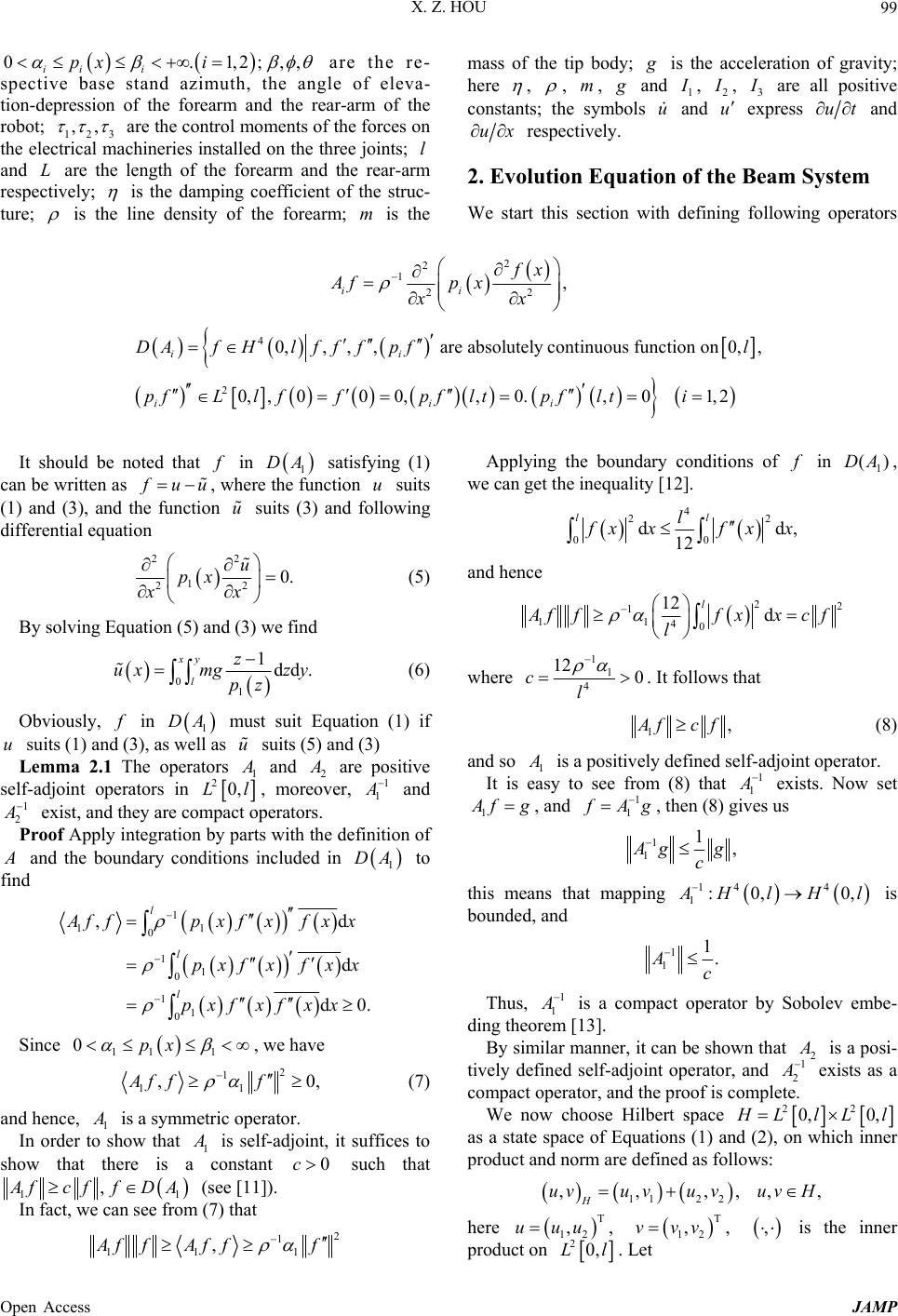 X. Z. HOU 99 0.1 ii i pxi ,2;,, ,, are the re- spective base stand azimuth, the angle of eleva- tion-depression of the forearm and the rear-arm of the robot; 123 L are the control moments of the forces on the electrical machineries installed on the three joints; and are the length of the forearm and the rear-arm respectively; l is the damping coefficient of the struc- ture; is the line density of the forearm; is the m mass of the tip body; is the acceleration of gravity; here , , , m and 1 , 2 , 3 are all positive constants; the symbols and express u uut and ux respectively. 2. Evolution Equation of the Beam System We start this section with defining following operators 2 2 1 22 , ii x Afp x xx 4 2 0,,,,are absolutely continuous function on0,, 0, ,000,,0.,01,2 ii iii DAfHlf ffpfl pfLl ffpfltpflti It should be noted that in satisfying (1) can be written as 1 DA uu , where the function suits (1) and (3), and the function suits (3) and following differential equation u u 22 1 22 0. u px xx (5) By solving Equation (5) and (3) we find 01 1dd . xy l z ux mgzy pz (6) Obviously, in must suit Equation (1) if suits (1) and (3), as well as suits (5) and (3) 1 DA uu Lemma 2.1 The operators 1 and 2 are positive self-adjoint operators in 2 L0,l, moreover, 1 1 and 1 2 exist, and they are compact operators. Proof Apply integration by parts with the definition of and the boundary conditions included in 1 DA to find 1 11 0 11 0 11 0 ,d d d0 l l l. ffpxf xfxx pxf xfxx pxfxfxx Since , we have 111 0px 2 1 11 ,0Af ff , (7) and hence, 1 is a symmetric operator. In order to show that 1 is self-adjoint, it suffices to show that there is a constant such that 0c 11 , fcffDA (see [11]). In fact, we can see from (7) that 2 1 11 1 , ff Afff Applying the boundary conditions of in , we can get the inequality [12]. f)( 1 AD 4 22 00 dd 12 ll l, xx fxx and hence 22 1 11 40 12 d l fffx xcf l where 11 4 12 0cl . It follows that 1, fcf (8) and so 1 is a positively defined self-adjoint operator. It is easy to see from (8) that 1 1 exists. Now set 1 fg , and 1 1 Ag , then (8) gives us 1 11, gg c this means that mapping 14 4 1:0, 0, HlHl is bounded, and 1 11.Ac Thus, 1 1 is a compact operator by Sobolev embe- ding theorem [13]. By similar manner, it can be shown that 2 is a posi- tively defined self-adjoint operator, and 1 2 exists as a compact operator, and the proof is complete. We now choose Hilbert space 22 0, 0, LlLl as a state space of Equations (1) and (2), on which inner product and norm are defined as follows: 1122 ,, ,,, H uvu vuvuvH , here is the inner roduct on T 12 ,,uuu T 12 ,,vvv , p 20,Ll. Let Open Access JAMP 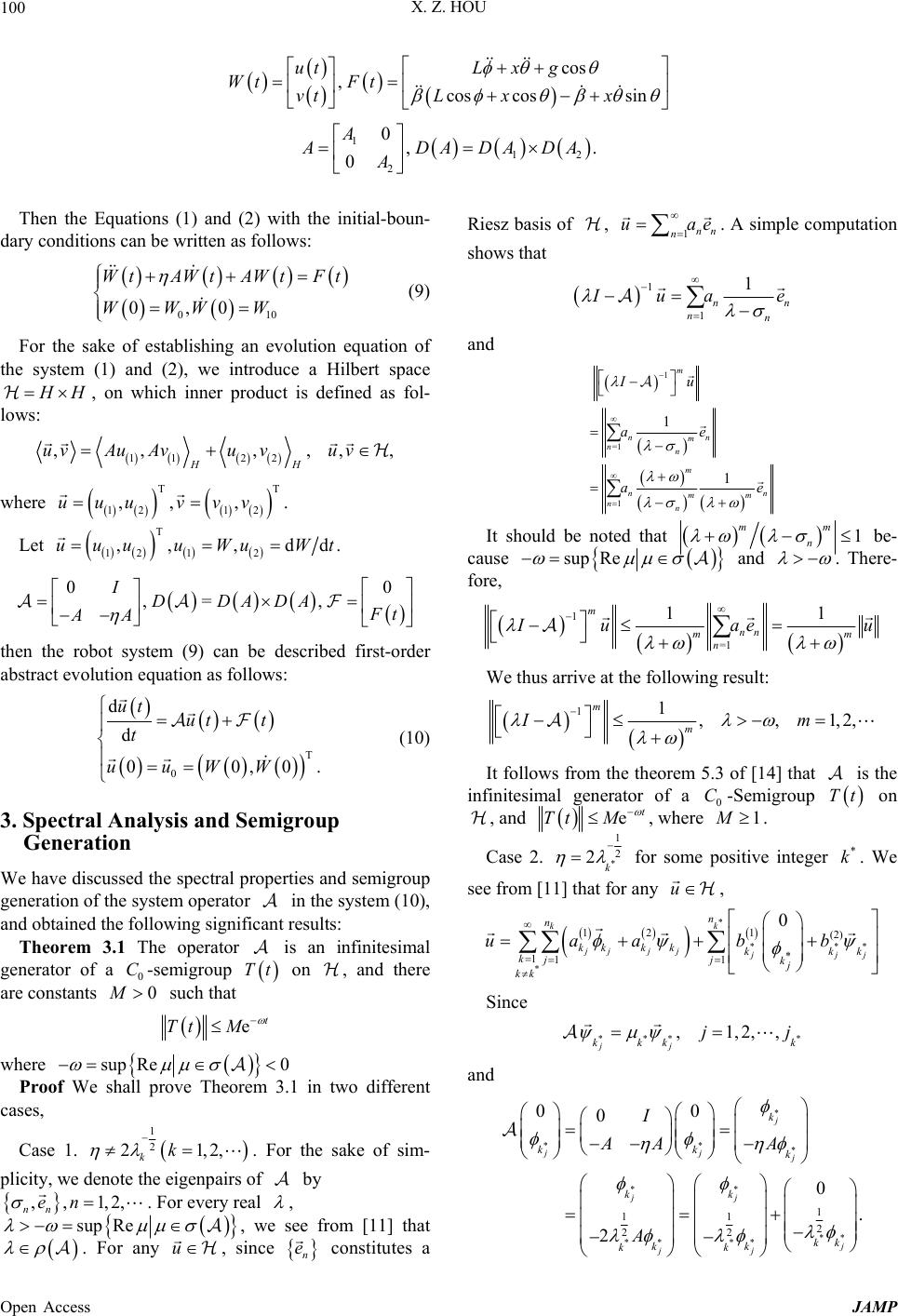 X. Z. HOU 100 cos ,cos cossin ut Lxg Wt Ft vt Lx x 112 2 0,. 0 A DA DA DA A Then the Equations (1) and (2) with the initial-boun- dary conditions can be written as fo llows: 010 0,0 WtAWt AWtFt WWWW (9) For the sake of establishing an evolution equation of the system (1) and (2), we introduce a Hilbert space H, on which inner product is defined as fol- lows: 11 22 ,, ,,, HH u vAuAvuvu v , . where TT 12 12 ,, ,uuu vvv Let T 12 12 ,, ,dduuuu WuWt . 0 0,= , IDDADAFt AA then the robot system (9) can be described first-order abstract evolution equation as follows: T 0 d d 00, ut ut t t uuWW 0. (10) 3. Spectral Analysis and Semigroup Generation We have discussed the spectral properties and semigroup generation of the system operator in the system (10), and obtained the following significant results: Theorem 3.1 The operator is an infinitesimal generator of a -semigroup on , and there are constants such that 0 C M Tt 0 et TtM where sup Re0 Proof We shall prove Theorem 3.1 in two different cases, Case 1. 1 2 21,2, kk . For the sake of sim- plicity, we denote the eigenpairs of by ,,1,2, nn en . For every real , sup Re e , we see from [11] that . For any u, since constitutes a n e Riesz basis of , 1nn n ua . A simple computation shows that 1 1 1 nn nn ua e and 1 =1 1 1 1 m nn m nn m nn mm nn Iu ae ae It should be noted that 1 m m n be- cause sup Re and . There- fore, 1 =1 11 m nn mm n uae u We thus arrive at the following result: 11,,1,2 m m Im , It follows from the theorem 5.3 of [14] that is the infinitesimal generator of a -Semigroup 0 C Tt on , and et TtM , where 1 . Case 2. * 1 2 2k for some positive integer . We * k see from [11] that for any u , * ** * * 121 (2) * 111 0 kk jj jj jj j n n kk kk kk k kjj kj kk uaa bb Since *** ,1,2,, jj kkk jj * k and * ** * ** * * ** ** 1 11 2 22 00 0 0 . 2 j jj j jj j jj k kk k kk k k kk kk I AA A A Open Access JAMP  X. Z. HOU 101 Since * 1 2 2k , we refer to 1) of Theorem 1 to find **** ** * ** * ** 2 11 2 22 * 1 2 11 22 42 2(2)4 2442 22, kkkk kk k k kk k kk 2 and so * ** ** **** 1 2 * 1 22 * 0 0. j jj jj jj k k kk kk kkkkk 0 Hence, the space spanned by ** * 1*** 1 0 0 ,, ,, jkjk kk k k * 2k j is an invariant subspace of dimensions of , denoted by . From theo ry of finit e dim e ns io na l space, w e as se rt that * k M ** , pp kk MM and therefore * *sup Re Mk sup Re * . k . Actually, we can arrange the vectors spanning as follows * k M ** * 12 * ** * 12 0 00 ,, ,,,, jk jk kk k kk Set ** * * 12 2, 0 kk k k then * k M has the form * * 0 there areinthe diagonal 0 k k js M Apply the result of [14] to conclude that generates a 0-semigroup satisfying C 1 Tt 11 et Tt M (11) On the other hand, since the family 11 * ,,,, jj kk kkk k kk consists of the eigenvectors of , the subspace spanned by them is an invari- ant subspace of , and this family is just a Riesz basis of [5]. Thus, form case 1, it is aware of the fast that generates a 0-Semigroup in . For M M C 2,0Tt tM M, we have 1 1* 1, 11, 2,,; jj jj kk k kk k k I jnk k and k , it follows from [16] that 1 k I MM k M and 2sup Rek M sup Re . Thus, there is 2 such that 22 et TtM (12) Since * is finite dimensional, it is a closed sub- space of , and so *k k k M MM, where ex- presses orthogonal sum in Hilbert space . Now, we define 2 T t def Tt1 Tt (obviously, 0 12 21 TtTtTtt T ). We shall next prove an interesting result that Tt is exactly a 0-semigroup on generated by . The semigroup properties of C Tt can be easily presented as follows: 1) 0T II * 12 k kI00TT MM 2) 12 112 2 121 2 ,0 Tt sTt sTt s TtTs TtTs TtTtTs Ts TtTs ts 3) For every x , *k k xx , where , ** kk xM kk x M, * * * * * 12 00 12 00 12 12 0 12 00 lim lim lim lim lim lim lim k k tt k tt k k k t k k tt k k TtxTtTtxx TtxTtTtx TtTtx TtxTtx TtxTtx xxx 4) For any xD, we have *k k xx, and * k xM * 11 et Tt M , and so * kkk x M, and Open Access JAMP 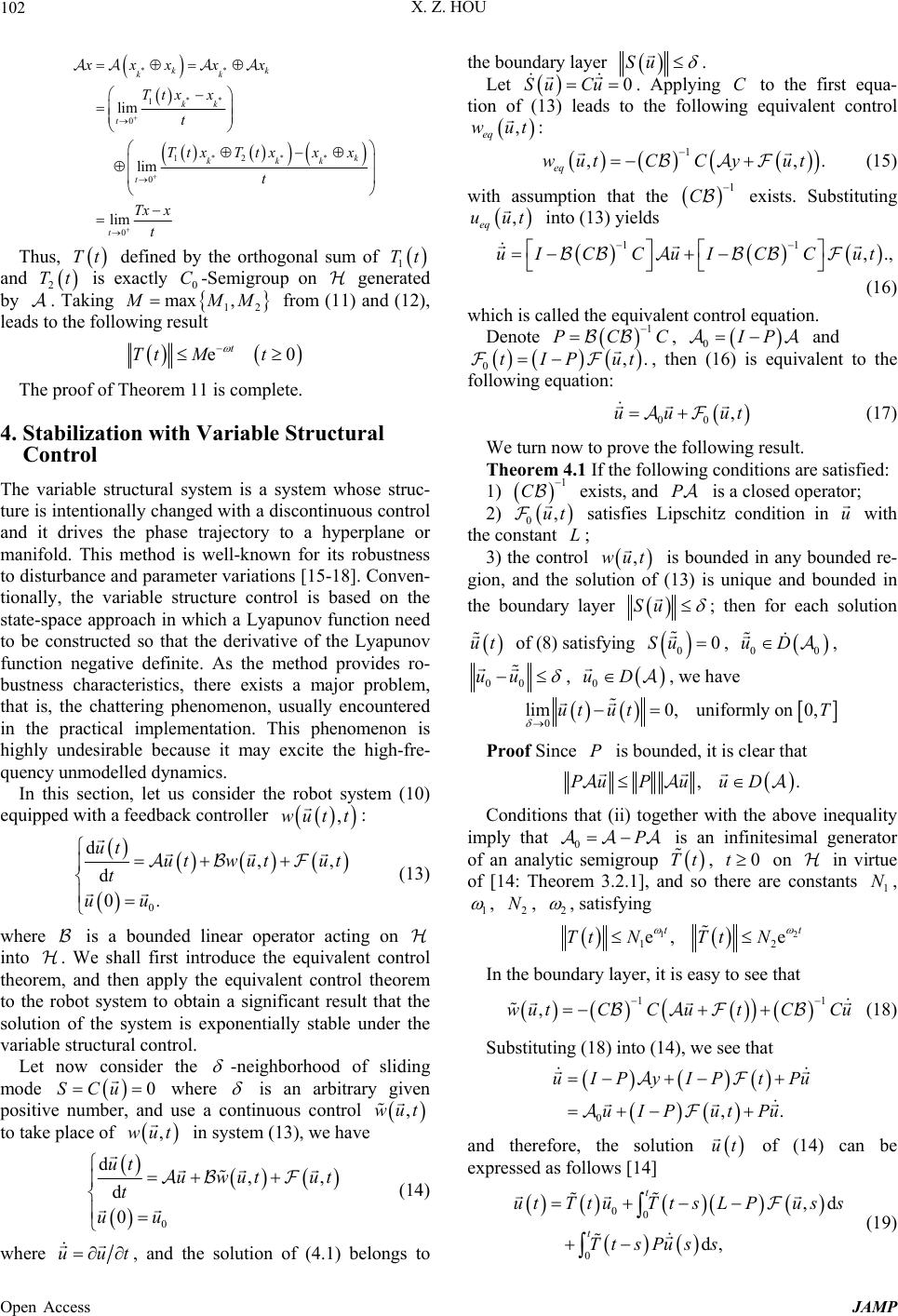 X. Z. HOU 102 ** ** *** 1 0 12 0 0 lim lim lim kk kk kk t k kkk t t xxx xx Ttxx t Ttx Ttxxx t Tx x t Thus, defined by the orthogonal sum of Tt 1 Tt and 2 is exactly -Semigroup on generated by . Taking tT 0 C max 12 , MM from (11) and (12), leads to the following result e0 t Tt Mt The proof of Theorem 11 is complete. 4. Stabilization with Variable Structural Control The variable structural system is a system whose struc- ture is intentionally changed with a discontinuous control and it drives the phase trajectory to a hyperplane or manifold. This method is well-known for its robustness to disturbance and parameter variations [15-18]. Conven- tionally, the variable structure control is based on the state-space approach in which a Lyapunov function need to be constructed so that the derivative of the Lyapunov function negative definite. As the method provides ro- bustness characteristics, there exists a major problem, that is, the chattering phenomenon, usually encountered in the practical implementation. This phenomenon is highly undesirable because it may excite the high-fre- quency u n model l ed dynamics. In this section, let us consider the robot system (10) equipped with a feedbac k contr o l le r : ,wut t 0 d, d 0. ut ut wutut t uu , (13) where is a bounded linear operator acting on into . We shall first introduce the equivalent control theorem, and then apply the equivalent control theorem to the robot system to obtain a significant result that the solution of the system is exponentially stable under the variable structural control. Let now consider the -neighborhood of sliding mode where 0SCu is an arbitrary given positive number, and use a continuous control ,wut to take place of in system (13), we have ,wu t 0 d, d 0 ut u wutut t uu , (14) where uu t, and the solution of (4.1) belongs to the boundary layer Su . Let 0Su Cu . Applying to the first equa- tion of (13) leads to the following equivalent control C ,t eq wu : 1 ,, eq wutCC yut . (15) with assumption that the exists. Substituting 1 C , eq uut into (13) yields 11 ,.,uI CCuI CCut (16) which is called the equivalent cont rol eq uatio n. Denote 1 CC , and 0IP ,.Put 0tI , then (16) is equivalent to the following equation: 00 ,uu u t (17) We turn now to prove the following result. Theorem 4.1 If the following conditions are satisfied: 1) 1 C exists, and is a closed operator; P 2) 0,ut satisfies Lipschitz condition in u with the constant ; L 3) the control ,wut is bounded in any bounded re- gion, and the solution of (13) is unique and bounded in the boundary layer Su ; then for each solution ut of (8) satisfying 00Su , , 00 uD 00 uu , 0 uD , we have 0 lim 0ut ut,uniformly on0,T Proof Since is bounded, it is clear that P ,.PuPuu D Conditions that (ii) together with the above inequality imply that 0P is an infinitesimal generator of an analytic semigroup , on in virtue of [14: Theorem 3.2.1], and so there are constants , Tt 0t 1 N 1 , , 2 N2 , satisfying 12 12 e, e tt Tt NTt N In the boundary layer, it is easy to see that 11 ,wutC CutC Cu (18) Substituting (18) into (14), we see that 0,. uIPyIP tPu uIP utPu and therefore, the solution ut of (14) can be expressed as follows [14] 00 0 ,d d, t t utTtuTtsLPuss Tt sPus s (19) Open Access JAMP 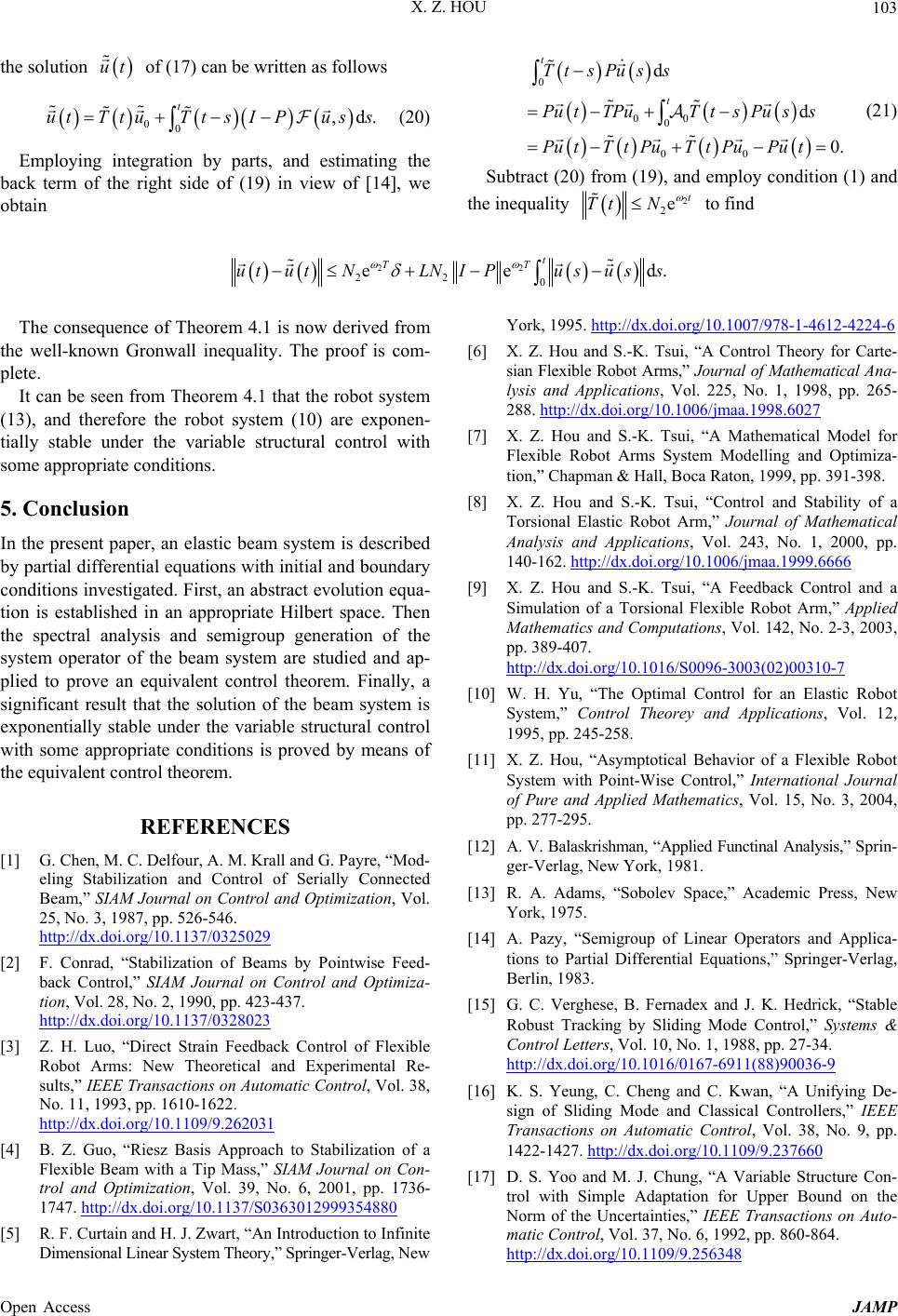 X. Z. HOU Open Access JAMP 103 the solution of (17) can be written as follows (20) int the back term of the right side of (19) in view of [14], we obtain ut 0 00 0 00 d d 0. t t Tt sPuss Pu tTPuT ts Puss PutT tPuT t PuPut (21) 00,d. t utTtuTt s IPuss Employingegration by parts, and estimatingSubtract (20) from (19), and employ condition (1) and the inequality 2 2et Tt N to find 2 2 e T ut utNLN 2 20 ed. t T I Pususs The consequence of Theorem 4.1 is now derived from the well-known Gronwall inequality. The proof is com- plete. system is described by partial differential equations with initial and boundary ated. First, an abstract evolution equa- . Krall and G. Payre, “Mod- eling Stabilization and Control of Serially Connected Beam,” SIAM Optimization, Vol 25, No. 3, 198 It can be seen from Theorem 4.1 that the robot system (13), and therefore the robot system (10) are exponen- tially stable under the variable structural control with some appropriate conditions. 5. Conclusion In the present paper, an elastic beam conditions investig tion is established in an appropriate Hilbert space. Then the spectral analysis and semigroup generation of the system operator of the beam system are studied and ap- plied to prove an equivalent control theorem. Finally, a significant result that the solution of the beam system is exponentially stable under the variable structural control with some appropriate conditions is proved by means of the equivalent control theorem. REFERENCES [1] G. Chen, M. C. Delfour, A. M . Journal on Control and 7, pp. 526-546. http://dx.doi.org/10.1137/0325029 [2] F. Conrad, “Stabilization of Beams by Pointwise Feed- back Control,” SIAM Journal on Control and Optimiza- tion, Vol. 28, No. 2, 1990, pp. 423-437. http://dx.doi.org/10.1137/0328023 [3] Z. H. Luo, “Direct Strain Feedback Control of Flexible Robot Arms: New Theoretical and Experimental Re- sults,” IEEE Transactions on Automatic C No. 11, 1993, pp. 1610-1622. ontrol, Vol. 38, http://dx.doi.org/10.1109/9.262031 [4] B. Z. Guo, “Riesz Basis Approach to Stabilization of a Flexible Beam with a Tip Mass,” SIAM Journal on Con- trol and Optimization, Vol. 39, N 1747. o. 6, 2001, pp. 1736- 3012999354880 http://dx.doi.org/10.1137/S036 York, 1995. http://dx.doi.org/10.1007/978-1-4612-4224-6 [6] X. Z. Hou and S.-K. Tsui, “A Control Theory for Carte- sian Flexible Robot Arms,” Journal of Mathematical Ana- lysis and Applications, Vol. 225, No. 1, 1998, pp. 265- 288. http://dx.doi.org/10.1006/jmaa.1998.6027 [7] X. Z. Hou and S.-K. Tsui, “A Mathematical Model for Flexible Robot Arms System Modelling and Optimiza- tion,” Chapman & Hall, Boca Raton, 1999, pp. 391-398. [8] X. Z. Hou and S.-K. Tsui, “Control and Stability of a Torsional Elastic Robot Arm,” Journal of Mathematical Analysis and Applications, Vol. 243, No. 1, 2000, pp. 140-162. http://dx.doi.org/10.1006/jmaa.1999.6666 [9] X. Z. Hou and S.-K. Tsui, “A Feedback Control and a Simulation of a Torsional Flexible Robot Arm,” Applied Mathematics and Computations, Vol. 142, No. 2-3, 2003, pp. 389-407. http://dx.doi.org/10.1016/S0096-3003(02)00310-7 [10] W. H. Yu, “The Optimal Control for an Elastic Robot System,” Control Theorey and Applications, Vol. 12, 1995, pp. 245-258. [11] X. Z. Hou, “Asymptotical Behavior of a Flexible Robot System with Point-Wise Control,” International Journal of Pure and Applied Mathematics, Vol. 15, No. 3, 2004, pp. 277-295. [12] A. V. Balaskrishman, “Applied Functi nal Analysis,” Spri n- ger-Verlag, New York, 1981. [13] R. A. Adams, “Sobolev Space,” Academic Press, New York, 1975. [14] A. Pazy, “Semigroup of Linear Operators and Applica- tions to Partial Differential Equations,” Springer-Verlag, Berlin, 1983. [15] G. C. Verghese, B. Fernadex and J. K. Hedrick, “Stable Robust Tracking by Sliding Mode Control,” Systems & Control Letters, Vol. 10, No. 1, 1988, pp. 27-34. http://dx.doi.org/10.1016/0167-6911(88)90036-9 [16] K. S. Yeung, C. Cheng and C. Kwan, “A Unifying De- sign of Sliding Mode and Classical Controllers,” IEEE Transactions on Automatic Control, Vol. 38, No. 9, pp. 1422-1427. http://dx.doi.org/10.1109/9.237660 Auto- [17] D. S. Yoo and M. J. Chung, “A Variable Structure Con- trol with Simple Adaptation for Upper Bound on the Norm of the Uncertainties,” IEEE Transactions on matic Control, Vol. 37, No. 6, 1992, pp. 860-864. [5] R. F. Curtain and H. J. Zwart, “An Introduction to Infinite Dimensional Linear System Theory,” Springer-Verlag, New http://dx.doi.org/10.1109/9.256348 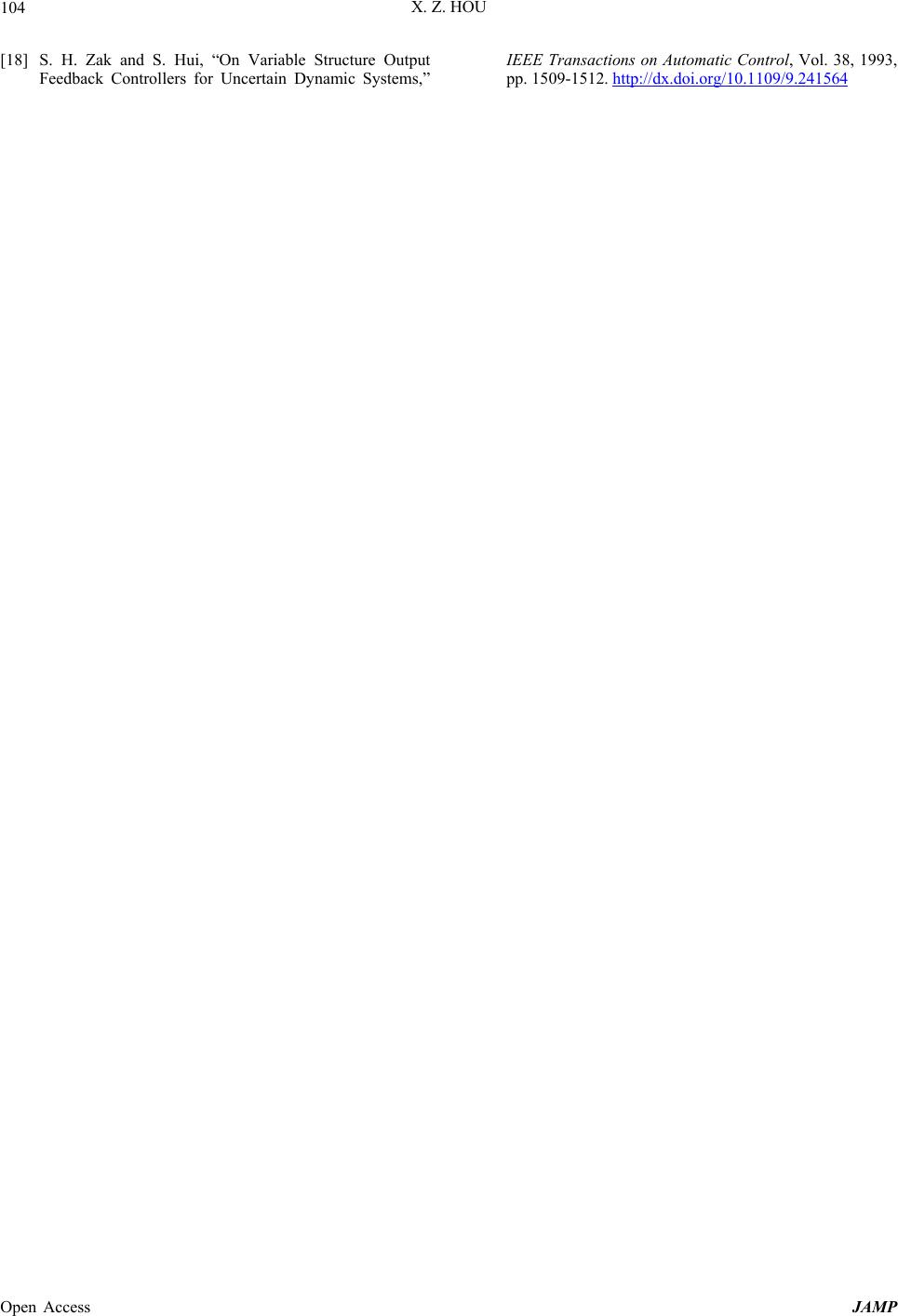 X. Z. HOU 104 [18] S. H. Zak and S. Hui, “On Variable Structure Output Feedback Controllers for Uncertain Dynamic Systems,” IEEE Transactions on Automatic Control, Vol. 38, 1993 pp. 1509-1512. , 109/9.241564http://dx.doi.org/10.1 Open Access JAMP
|